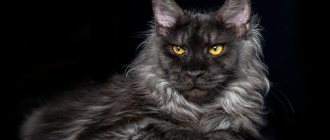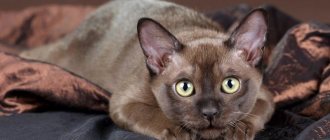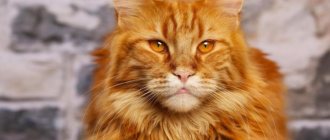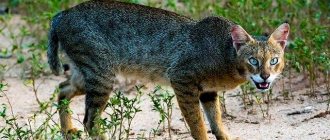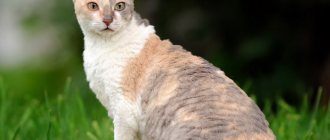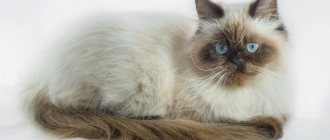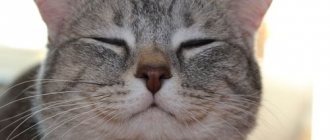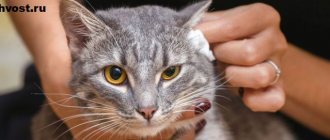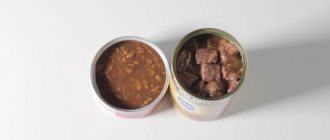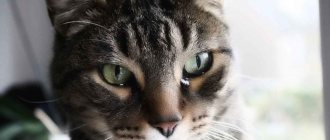The expression “yoshkin cat” is used to mean “wow!”, “wow!”, “well, well!”, “wow!” The phrase expresses surprise, misunderstanding, disappointment, annoyance. There is no exact analogue for it in other languages of the world. The closest emotional connotation in English is perhaps the expression “holy molly”; it is with this expression that translators replace our “tree-sticks”, “exel-moksel” and the mysterious “eperesete”. But the cat, with which a certain shock can be compared, is a phenomenon of exclusively Slavic culture. Where could Yoshkin's cat come from and what did it mean to our ancestors?
Character
If we recall Russian folklore, in particular folk tales and Baba Yaga, who appears in most of them, her cat appears before readers in the form of Kota-Bayun. This beast is black in color and huge in size, feeds on human remains, and is capable of hypnotizing a person with its magical voice.
Yaga the cat deserves a special treatment on a level with the universally remembered Devil or Dashing. But if we proceed from this option, then it is correct to call him Ezhkin. People are used to speaking differently.
New traditions
“Yoshkin cat” is a unique symbol of modern Yoshkar-Ola. Residents and guests of the city love to take photos next to it. Various signs also appeared: for example, by rubbing a cat’s bronze nose, you can count on good luck.
Any student is well aware of where “Yoshkin Kot” is located. After all, he became the mascot of the student fraternity and the object of student rituals, especially when it comes to the session. According to legend, by rubbing an animal's nose, you can count on successfully passing the exam. After defending your diploma, you should again approach the sculpture and stroke its nose.
By the way, today there are five cat-themed sculptural compositions in the city, and the name “Yoshkin the Cat” has been patented by officials as the city’s signature brand.
Sculpture address: pl. Lenina, house 1.
CONSPIRACY
If you don’t go into etymology and don’t believe fairy tales, this phrase can mean an ancient Slavic conspiracy. It was pronounced in order to protect one’s home, family and everything that is dear to a person from evil spirits. This was at a time when people did not yet know the origin of most things, and gave mythical explanations for all events. Then they uttered similar slander in speeches in order to call upon the forces of light and good spirits. Since those times, many other rituals and symbols have come to us, which are popular to this day.
cat Baiyun
Where are the roots from?
Maybe not Eshkin, but Ezhkin - the fairy-tale cat who lives with Baba Yaga? It is this version that philologists consider when studying the etymology of euphemism. If you carefully read fairy tales, especially without the author’s adaptation, you will notice that not only Yaga lives in the hut on chicken legs, but also a black cat. According to legend, this is Kot-Bayun, the son of Mother Earth-Cheese, who escorts people to the other world. Baba Yaga decided to outwit fate and become immortal. She received Bayun and treated him to human bones. Since then, Eshkin the cat has lived with Yaga.
These are just assumptions, but the study of myths about the animal also speaks in its favor. It is a cat that witches most often turn into. The sudden appearance of a strange cat in the house predicts trouble, and if the Ezhkin cat appears, then misfortunes will accompany the family for many years. This version is confirmed by the identification of the cat, although there are always many animals hanging around Yaga. The second proof is the expression “cat of a bitch” meaning “scoundrel”, “scoundrel”. Moreover, it was this character that the pagans called upon, trying to protect the house from evil spirits. And this is understandable: although the cat Hedgehog is evil and can cast the evil eye, at the same time he has the power to neutralize the enemy.
The negative emotional component is inherent in this expression and in the first letter “E”. Compare “E-moe”, “Ekarny (fucking) babay”, “Elki-palki”, “Eprst”, “Hedgehog your copper”. Perhaps this particular letter of the Russian alphabet is a protector from evil forces.
Euphemism literally burst into the vocabulary of modern man after the release of the film “Love and Doves.” The main character often used this expression very emotionally. They began to replace swear words so that the speech would be more harmonious, although this expression is not recorded in the Russian Mat dictionary.
Where does Eshkin the cat live?
The city of Yoshkar-Ola became a unique habitat for Eshka the cat, in the center of which a monument was erected to him in 2011. He depicts an animal lounging on a bench, well-fed and happy with life. The sculpture is located in the park near Mari State University. Therefore, local students have developed a peculiar tradition of scratching the cat’s nose in order to write and pass all exams.
Yoshkin the cat in Yoshkar-Ola
In the same city, another composition was installed, a very cute and sophisticated Yoshka cat. She became a friend of the cat lying nearby, from which the mouse was running away. Their creation was facilitated by the consonance of a common phrase with the humorous city name “Yoshka”.
Yoshka's cat in the same city
Monuments to an unusual cat
For some reason, in people’s imaginations, Eshkin the cat appears as a shaggy cat with huge bulging eyes. But if you believe fairy tales, he was an ordinary cat, only a little plump. The sculptors of the Mari El Republic decided to try to bring the image of a folklore character to life. It is in Yoshkar-Ola that the first monument to Eshkin’s cat is located. The authors had to work hard to cast a cat in bronze, which would reveal in its image the attitude of an ordinary person to extraordinary circumstances. And they succeeded: the Yoshkarolinsky cat turned out to be very emotional and with a cunning look in his eyes. An additional emotional component is the Naked Truth newspaper and the fish skeleton on it.
The cat’s name also had to be changed; instead of Eshkin, he became Yoshkin: the authors borrowed the first letter from the name of the city. So the bronze cat became the symbol of Yoshkar-Ola, which protects residents from evil and failure. He was especially loved by the students of the University of Mari, next to which there was a bench on which the cat sat. One has only to sit down next to him and rub Yoshka’s paw, all bad thoughts immediately disappear and leaves a feeling of annoyance.
The success of the first monument inspired the sculptors to create a new composition. In 2013, the sculpture “Yoshka’s Cat” appeared on Gagarin Avenue. They installed it near the cafe of the same name. The new monument is a figure of a large cunning cat holding a mouse with its paw, and a flirtatious cat. It is with such cunning that people should react to failures and annoyance, uttering the phrase “Eshkin cat.”
In 2015, the cat appeared on the city streets in a new form. This is a fluffy intellectual in a tailcoat who holds a coin in his paw. He lives on Voinov-Internationalist Street near the store. Maybe this is exactly what Yoshka’s cat was, and Baba Yaga could have had her own black tramp, Eshka?
The comic sculpture sank into people’s souls so much that in 2018 they decided to donate a copy of it to Simferopol. Now Crimean Yoshka lives on Karl Marx Street near the entertainment center. Residents of the city hope that this monument will mark the beginning of a whole series of comic sculptures that will decorate the streets and lift the spirits of the townspeople.
Head of Simferopol Administration Igor Lukashev and Head of Yoshkar-Ola City District Alexander Printsev
A little humor
This phrase often has a humorous connotation, although it comes from the name of Yaga’s dangerous and cunning accomplice. Ekarny babay, vigorous louse, vigorous matryona, and plaque-fly have similar properties. They all come out of Russian folklore, and are common only among the Russian people.
We can say that other countries are simply not suitable for them due to the wrong mentality of the local residents. But within the Federation, Eshkin the cat and other Slavic characters remain popular with people during moments of emotional outbursts, which happen very often.
1111
Folklore version
It can be assumed that the word “eshkin” indicates that it belongs to an owner named Eshka. According to one version, “Eshkin” is a distortion of “Ezhkin”, that is, the mysterious owner of the cat - Baba Yaga, familiar to everyone from childhood. After all, a classic witch must have a cat.
This version is contradicted by the fact that the word “eshkin” is spelled with the letter “sh” and has no other spelling options. But Grandma Ezhka is a character in oral folklore. If we assume that the hedgehog cat separated from the image of her, the hedgehog cat, and ceased to be associated with her quite a long time ago, then the substitution of the letter could have occurred simply because “f” and “sh” sound very similar. Even in the 19th century, the norms for the only correct spelling of words had not yet been adopted. In the correspondence of educated people of that time, you can see that the same word is often written differently by one author.
Mythical-historical interpretation
If we don’t remember the folklore origin and don’t go into the etymology, then the usual phrase is, according to some versions, part of a conspiracy widespread among the ancient Slavs.
It was pronounced in order to protect everything dear to a person from evil spirits. At that time, the origin of many things was unknown to people, so events received mythical interpretations.
Ancestors read such slander to call upon the forces of light. Since then, many interesting rituals have remained, and some have not been forgotten even now.
Ethnographic version
In Serbo-Croatian the word "jeza" means "horror", and in Slovenian it means "anger". In Czech “ezinka” is an evil woman, in Polish she is “edza”. These words are related to the Russian “Yaga” and have a connection with the Proto-Slavic designation for snakes.
It cannot be ruled out that the “Ezhkin” cat is not directly connected with Baba Yaga, but with more ancient words. The sound “zh” is consonant with “z” and “dz”. It is believed that the expression came from some ancient conspiracy.
The cat is a sacred animal in many cultures; the Slavs also attributed mystical qualities to it. There could very well be a conspiracy with the phrase "evil/terrible cat" or "snake cat". But there are no serious studies on this topic at the moment.
Emotions and humor
Often a well-known phrase takes on a humorous meaning, despite its origin from a very cunning and very dangerous assistant of a far from kind heroine of folklore.
The same overtones characterize the no less common “vigorous matryona” and “ekarny babai”. They also came from Russian folklore and became widespread in Russia.
Surely, the mentality of residents of other countries is not at all to the liking of the hero of the Russian expression, since outside the homeland the phrase with such a character did not take root.
But within the Russian Federation, Eshka’s cat is often remembered in moments of outburst of emotions.

